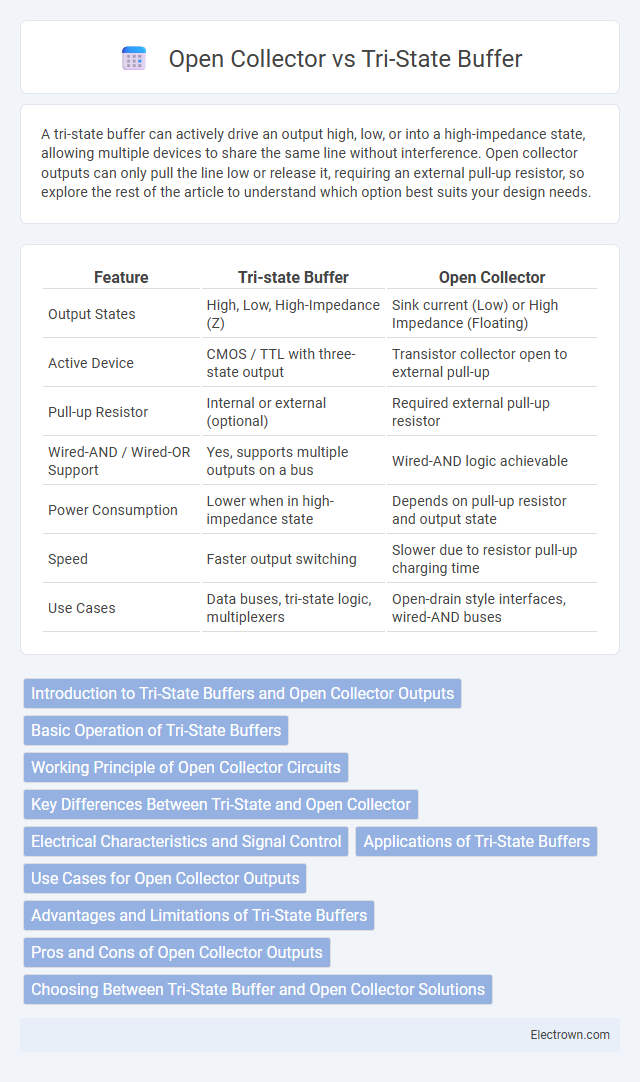A tri-state buffer can actively drive an output high, low, or into a high-impedance state, allowing multiple devices to share the same line without interference. Open collector outputs can only pull the line low or release it, requiring an external pull-up resistor, so explore the rest of the article to understand which option best suits your design needs.
Table of Comparison
| Feature | Tri-state Buffer | Open Collector |
|---|---|---|
| Output States | High, Low, High-Impedance (Z) | Sink current (Low) or High Impedance (Floating) |
| Active Device | CMOS / TTL with three-state output | Transistor collector open to external pull-up |
| Pull-up Resistor | Internal or external (optional) | Required external pull-up resistor |
| Wired-AND / Wired-OR Support | Yes, supports multiple outputs on a bus | Wired-AND logic achievable |
| Power Consumption | Lower when in high-impedance state | Depends on pull-up resistor and output state |
| Speed | Faster output switching | Slower due to resistor pull-up charging time |
| Use Cases | Data buses, tri-state logic, multiplexers | Open-drain style interfaces, wired-AND buses |
Introduction to Tri-State Buffers and Open Collector Outputs
Tri-state buffers provide three output states: high, low, and high-impedance, allowing multiple devices to share a common bus without interference, making them ideal for bus-oriented systems. Open collector outputs use transistors to pull the line low or leave it floating, requiring external pull-up resistors to achieve a high state, offering wired-AND logic capabilities. Understanding the differences helps you choose the appropriate output type for applications needing bus arbitration or logic level interfacing.
Basic Operation of Tri-State Buffers
Tri-state buffers control the output voltage by allowing it to be in one of three states: high, low, or high-impedance (floating), enabling multiple devices to share a single communication line without interference. The high-impedance state effectively disconnects the buffer's output, preventing bus contention and allowing other devices to drive the line. This tri-state functionality is essential for bus-oriented systems, increasing signal integrity and enabling efficient use of shared data paths.
Working Principle of Open Collector Circuits
Open collector circuits function by using a transistor with its collector terminal left unconnected internally, allowing the output to either sink current to ground or remain open, effectively enabling multiple outputs to be wired together in a wired-AND configuration. This design requires an external pull-up resistor to establish a defined high-level voltage when no transistor is conducting, making open collector outputs ideal for interfacing different voltage domains and for creating simple wired logic functions. Your application benefits from this flexibility when designing systems requiring shared bus lines or interrupt signaling.
Key Differences Between Tri-State and Open Collector
Tri-state buffers provide three output states: high, low, and high-impedance, allowing multiple devices to share a common bus without interference. Open collector outputs can only sink current, requiring an external pull-up resistor to achieve a high state, and are commonly used for wired-AND logic on shared lines. Tri-state buffers enable faster switching and precise control of bus contention, whereas open collector configurations offer simpler hardware but slower signal transitions due to passive pull-up resistors.
Electrical Characteristics and Signal Control
Tri-state buffers provide three output states: high, low, and high-impedance, allowing multiple devices to share a common bus without interference, controlled through an enable pin that isolates the output when inactive. Open collector outputs can only pull the line low or leave it floating, requiring external pull-up resistors for a defined high state, which facilitates wired-AND logic in multiple device connections. Electrical characteristics of tri-state buffers offer faster switching and more precise voltage levels, while open collector outputs are more robust for mixed voltage systems but slower due to the passive pull-up mechanism.
Applications of Tri-State Buffers
Tri-state buffers are essential in systems requiring multiple devices to share a common data bus without interference, such as in microprocessor buses and memory modules. They enable one device at a time to drive the line, allowing others to remain in a high-impedance state and preventing signal contention. Your design benefits from tri-state buffers when controlling bidirectional data flow or creating multiplexed communication channels.
Use Cases for Open Collector Outputs
Open collector outputs are ideal for interfacing with different voltage levels and creating wired-AND logic functions in digital circuits. They are commonly used in bus systems, such as I2C communication, where multiple devices share a signal line. These outputs provide flexibility for turning on external transistors or LEDs and allow multiple devices to safely connect to a single line without direct electrical conflict.
Advantages and Limitations of Tri-State Buffers
Tri-state buffers offer the advantage of enabling multiple devices to share a common data bus without interference by providing three output states: high, low, and high-impedance. This high-impedance state effectively isolates the device from the bus, preventing signal contention and reducing power consumption compared to open collector outputs. However, limitations include increased complexity in control logic and potential signal integrity issues if bus termination is not properly managed.
Pros and Cons of Open Collector Outputs
Open collector outputs offer advantages such as the ability to interface with different voltage levels and enable wired-AND configurations for multiple devices on a single bus. However, they require an external pull-up resistor, which can slow signal transitions and increase power consumption. These outputs are also limited in speed compared to tri-state buffers and cannot actively drive the line high, relying on external components for proper signal integrity.
Choosing Between Tri-State Buffer and Open Collector Solutions
Choosing between tri-state buffer and open collector solutions depends on your specific application needs such as signal integrity, bus sharing, and power efficiency. Tri-state buffers provide three output states--high, low, and high impedance--making them ideal for bus-oriented communication systems requiring multiple devices to share a common line without interference. Open collector outputs sink current but cannot source it, demanding external pull-up resistors and offering simpler wired-AND logic, which can be useful in situations requiring multiple device control lines with fail-safe signaling.
Tri-state buffer vs open collector Infographic

 electrown.com
electrown.com